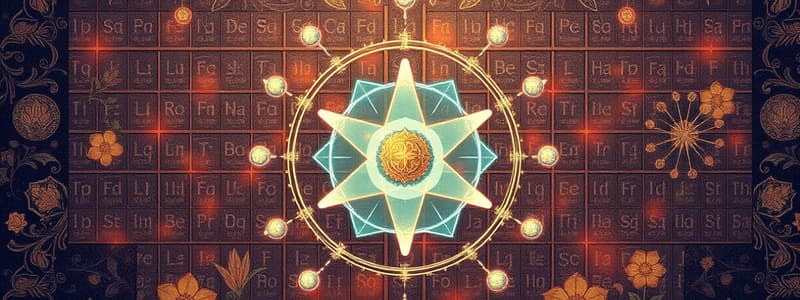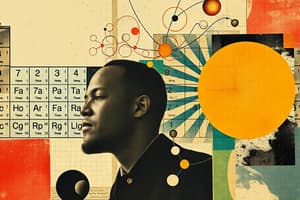Podcast
Questions and Answers
What does the pH scale measure?
What does the pH scale measure?
- Density of a liquid
- Electrical conductivity of a solution
- Acidity or alkalinity of a solution (correct)
- Temperature of a substance
What is the primary characteristic of endothermic reactions?
What is the primary characteristic of endothermic reactions?
- Release heat to the surroundings
- Absorb heat from the surroundings (correct)
- Increase temperature of the surroundings
- Occur spontaneously at room temperature
Which factor does NOT affect the rate of a chemical reaction?
Which factor does NOT affect the rate of a chemical reaction?
- Molecular mass of products (correct)
- Concentration of reactants
- Surface area of reactants
- Presence of catalysts
What defines a hydrocarbon?
What defines a hydrocarbon?
What is personal protective equipment (PPE) NOT typically comprised of?
What is personal protective equipment (PPE) NOT typically comprised of?
What particles are found in the nucleus of an atom?
What particles are found in the nucleus of an atom?
Which of the following describes a covalent bond?
Which of the following describes a covalent bond?
In the periodic table, what do periods represent?
In the periodic table, what do periods represent?
Which reaction type is represented by the equation A + BC → AC + B?
Which reaction type is represented by the equation A + BC → AC + B?
What is the pH range of acids?
What is the pH range of acids?
How many particles are in a mole according to Avogadro's number?
How many particles are in a mole according to Avogadro's number?
What characterizes a metal in classification of elements?
What characterizes a metal in classification of elements?
What is formed when two or more elements chemically bond?
What is formed when two or more elements chemically bond?
Flashcards are hidden until you start studying
Study Notes
Basic Concepts of Chemistry
- Matter: Anything that has mass and occupies space. Exists in three states: solid, liquid, gas.
- Atoms: Basic units of matter; consist of protons, neutrons, and electrons.
- Protons: Positively charged, found in the nucleus.
- Neutrons: Neutral charge, also in the nucleus.
- Electrons: Negatively charged, orbit the nucleus in energy levels.
Atomic Structure
- Element: A pure substance made of one type of atom.
- Compound: A substance formed when two or more elements chemically bond.
- Molecule: Smallest unit of a compound, consisting of two or more atoms.
The Periodic Table
- Groups: Vertical columns; elements have similar properties.
- Periods: Horizontal rows; indicate the number of energy levels.
- Metals, Nonmetals, and Metalloids: Classification based on physical and chemical properties.
Chemical Bonds
- Ionic Bonds: Formed when electrons are transferred from one atom to another, resulting in charged ions.
- Covalent Bonds: Formed when atoms share electrons.
- Metallic Bonds: Involves a sea of delocalized electrons among metal atoms.
Chemical Reactions
- Reactants and Products: Substances that undergo change are reactants; substances formed are products.
- Types of Reactions:
- Synthesis: A + B → AB
- Decomposition: AB → A + B
- Single Replacement: A + BC → AC + B
- Double Replacement: AB + CD → AD + CB
- Combustion: Hydrocarbon + O₂ → CO₂ + H₂O
Stoichiometry
- Mole Concept: A mole represents 6.022 × 10²³ particles (Avogadro's number).
- Molar Mass: The mass of one mole of a substance, measured in grams per mole (g/mol).
- Conversions: Use molar mass to convert between grams and moles.
Acids and Bases
- Acids: Substances that donate protons (H⁺ ions); have a pH less than 7.
- Bases: Substances that accept protons or donate hydroxide ions (OH⁻); have a pH greater than 7.
- pH Scale: Measures acidity or alkalinity; ranges from 0 (strong acid) to 14 (strong base).
Thermochemistry
- Endothermic Reactions: Absorb heat from the surroundings.
- Exothermic Reactions: Release heat to the surroundings.
- Enthalpy (ΔH): Measure of heat change during a chemical reaction.
Kinetics and Equilibrium
- Reaction Rate: The speed at which reactants are converted to products.
- Factors Affecting Rate: Concentration, temperature, surface area, presence of catalysts.
- Dynamic Equilibrium: The state when the rates of the forward and reverse reactions are equal.
Organic Chemistry
- Hydrocarbons: Compounds made of carbon and hydrogen; can be aliphatic or aromatic.
- Functional Groups: Specific groups of atoms that determine the characteristics and reactivity of organic compounds (e.g., hydroxyl, carboxyl).
- Isomerism: Compounds with the same formula but different structures or arrangements.
Inorganic Chemistry
- Salts: Ionic compounds formed from the neutralization reaction of an acid and a base.
- Coordination Compounds: Complexes formed by a central metal atom bonded to surrounding ligands.
- Transition Metals: Elements found in groups 3-12, known for variable oxidation states and formation of colored compounds.
Safety in Chemistry
- Personal Protective Equipment (PPE): Safety goggles, gloves, lab coats.
- Chemical Safety: Proper handling, storage, and disposal of chemicals; understanding Material Safety Data Sheets (MSDS).
Basic Concepts of Chemistry
- Matter encompasses anything with mass that occupies space, existing in solid, liquid, and gas states.
- Atoms are the fundamental units of matter, composed of protons, neutrons, and electrons.
- Protons carry a positive charge and reside in the nucleus of an atom.
- Neutrons are neutral particles located in the nucleus, contributing to atomic mass.
- Electrons are negatively charged and orbit the nucleus in defined energy levels.
Atomic Structure
- An element is a pure substance made entirely of one type of atom.
- A compound results from chemical bonding between two or more different elements.
- Molecules represent the smallest unit of a compound, formed by two or more atoms bonded together.
The Periodic Table
- Groups in the periodic table are vertical columns where elements share similar properties.
- Periods are horizontal rows that reflect the number of energy levels in the atoms of the elements.
- Elements are classified as metals, nonmetals, and metalloids based on their physical and chemical attributes.
Chemical Bonds
- Ionic bonds occur through the transfer of electrons, generating charged ions.
- Covalent bonds form when two or more atoms share electrons.
- Metallic bonds consist of a "sea" of delocalized electrons among metal atoms, enabling conductivity and malleability.
Chemical Reactions
- Reactants are the substances that undergo changes in a chemical reaction, while products are the resulting substances.
- Types of chemical reactions include:
- Synthesis: Combines reactants to form one product (A + B → AB).
- Decomposition: Breaks down a compound into simpler substances (AB → A + B).
- Single Replacement: An element replaces another in a compound (A + BC → AC + B).
- Double Replacement: Exchange of ions between two compounds (AB + CD → AD + CB).
- Combustion: Involves a hydrocarbon and oxygen producing carbon dioxide and water (Hydrocarbon + O₂ → CO₂ + H₂O).
Stoichiometry
- The mole concept represents a quantity of 6.022 × 10²³ particles, known as Avogadro's number.
- Molar mass is the mass of one mole of a substance, expressed in grams per mole (g/mol).
- Conversions between grams and moles are often performed using molar mass.
Acids and Bases
- Acids are substances that donate protons (H⁺ ions) and generally have a pH below 7.
- Bases accept protons or donate hydroxide ions (OH⁻) with a pH above 7.
- The pH scale measures acidity from 0 (strong acid) to 14 (strong base).
Thermochemistry
- Endothermic reactions absorb heat, leading to a decrease in temperature of the surroundings.
- Exothermic reactions release heat, resulting in an increase in temperature of the surroundings.
- Enthalpy (ΔH) quantifies the heat change associated with chemical reactions.
Kinetics and Equilibrium
- The reaction rate indicates how quickly reactants are transformed into products.
- Factors influencing reaction rate include concentration, temperature, surface area, and catalysts' presence.
- Dynamic equilibrium exists when the rates of forward and reverse reactions are in balance.
Organic Chemistry
- Hydrocarbons are compounds composed solely of carbon and hydrogen, categorized as aliphatic or aromatic.
- Functional groups are specific atom arrangements that influence the chemical properties and reactivity of organic molecules (e.g., hydroxyl, carboxyl).
- Isomerism refers to compounds that share the same molecular formula but differ in structure or arrangement.
Inorganic Chemistry
- Salts are ionic compounds produced from acid-base neutralization reactions.
- Coordination compounds involve a central metal atom bonded to surrounding ligands.
- Transition metals, located in groups 3-12, are characterized by variable oxidation states and the ability to form colored compounds.
Safety in Chemistry
- Personal Protective Equipment (PPE) includes safety goggles, gloves, and lab coats to ensure safe handling of chemicals.
- Chemical safety encompasses proper handling, storage, and disposal practices along with a solid understanding of Material Safety Data Sheets (MSDS).
Studying That Suits You
Use AI to generate personalized quizzes and flashcards to suit your learning preferences.




